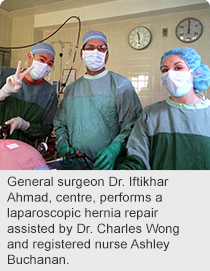
March 16, 2015
Story by Kerri Robins; photos courtesy Dr. Iftikhar Ahmad and Sharlene Henry
When Tom Oldridge had to have a colonoscopy at the St. Therese - St. Paul Healthcare Centre in February, it was a scary thought.
“It was the first time I’d had one, but it was necessary because my mother had colon cancer and the doctors wanted to do a diagnosis after they suspected bleeding in my colon,” says Oldridge, 75. “But I was able to have the procedure close to my home near St. Paul — and I was back to work that day.”
Oldridge’s colonoscopy is one of the endoscopic procedures performed at the health centre. Last September, some new equipment arrived, thanks to funding from the St. Paul & District Hospital Foundation. The foundation helped purchase two new laparoscopic cameras, a new set of laparoscopic instruments, a high-definition monitor and a new gastroscope to add to the capacity of the two existing ones for the St. Therese - St. Paul Healthcare Centre. The new equipment cost $40,000.
 General surgeon Dr. Iftikhar Ahmad says he’s pleased with the new equipment.
General surgeon Dr. Iftikhar Ahmad says he’s pleased with the new equipment.
“The gastroscope, used in endoscopic procedures, and the laparoscopic equipment are great diagnostic and screening tools allowing us to diagnose a number of different conditions,” says Dr. Ahmad, “including colon cancer, colon polyps, inflammatory bowel disease, peptic ulcers, hernias and stomach and/or colon bleeding. And we can remove tumours and polyps during the procedure if need be.”
Both laparoscopies and endoscopies are minimally invasive procedures. During a typical laparoscopy, patients are sedated and up to three small incisions are made in the abdomen. Using laparoscopic tools and a camera, the surgeon can “see” the patient’s abdominal cavity on a monitor.
The new camera also swivels, affording a 30-degree internal view, while the old camera, still in use, gives a simple straight-on view. Viewing on the new high-definition flat-screen monitor also gives surgeons a crisper, clearer image.
“The new laparoscopic cameras give a much wider view of the area I’m working on, which makes it easier to focus on and treat the problem at hand,” says Ahmad.
Because such tiny incisions are made, the risk of infection is reduced. As well, patients can return to light work in about one to two weeks — about four weeks earlier than with open surgery.
The endoscopic equipment (both gastroscope and colonoscope) relies upon thin flexible tubing, tipped with a small camera, that’s inserted through the patient’s mouth or rectum.
The gastroscope is used to examine the esophagus, the interior of the stomach and the duodenum — the very top of the small intestine. The colonoscope examines the entire colon. While the tubing may be similar in style and material, separate tubing is used specific to the area the doctor is interested in seeing.
“Because of the extra endoscope, I can perform an average of 12 more endoscopes per month – bringing the total per month to an average of 50,” says Ahmad. “And we’ve doubled our laparoscopies so now at least 12 laparoscopies per month are performed. Having the equipment means patients don’t have to travel to Edmonton for these procedures.”
Linda Kryzanowski, Chair of the St. Paul & District Hospital Foundation, applauds the community support.
“Our community members and business leaders are committed to supporting local health care,” says Kryzanowski. “I’m proud to be part of such a caring group.”
As for Oldridge?
He says he’s very happy with the care he received.
“I’ve been given a clean bill of health now — I’m even better than I was before.”
For more information, please visit albertahealthservices.ca/give.